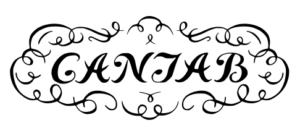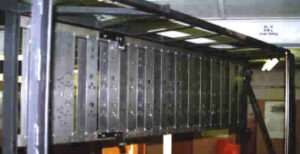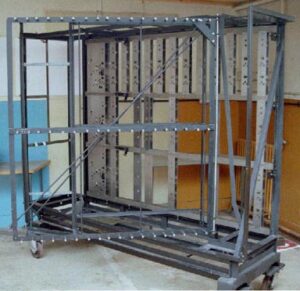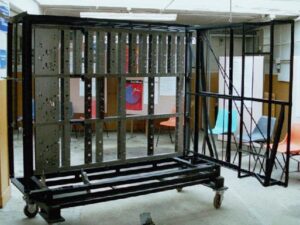FRAME & HORIZONTAL BARS
In January 1999 we test fitted the top bank of 13 pairs of mounting plates. Referring to the image below, which is looking from the rear of the machine, the carry cams and mechanisms were later fitted between the left pair of plates. The other 12 pairs of narrower plates had the drum commutators fitted to the front and the drive systems between and to the rear of the plates. At this point of construction, the middle and lower banks have still to be fitted.
The view above shows the rear of the machine. Please bear this in mind because when we refer to a right or left ends these are taken as when viewed from the front (drum side) of the Bombe.
If one peers through the frame above it is possible to see a full set of plates fitted to the top bank of Enigmas and a selection also fitted to the middle and lower banks. These plates are not at this stage fully machined and were later removed to be worked on by the Harlow team. What is significant is that we had proved that we have a true and square assembly of about 6 foot by 5 foot in size mounted inside our original frame. To those involved, this was a major achievement because it proved the manufacturing accuracy of the plates and the four heavy horizontal bars. It has also proved that around 800 holes were drilled in the correct place and where these holes are threaded these were correct.
Rear views of our Rebuild.
In this rear view, two of the nine Jack support bar pairs have been fitted to check accuracy. These were then been removed and were taken away from Bletchley Park to be built up with Jacks.
It is not easy to see but the tall vertical framework with the angle sections reaching back to the heavy horizontal bars is the Circuit Breaker frame. Three timing sub-assemblies were later mounted here driven through spur gears from the Carry Cam Shafts.
This completes the frame construction
View plate assembly construction
BOMBE FRAMES
If we leave aside the early prototypes and experimental machines, there were two types of Bombe Frame produced by BTM during WW II. The first type was used as part of the first ‘3 wheel’ Bombes delivered between March 1940 and March 1943.
By 1943 the urgent need to break German 4-wheel Enigma codes could be addressed in anger when the first BTM 4 Wheel Bombes were delivered. It was these machines that brought about the second type of frame which added a major heavy section at the right-hand end. This section was required to mount the additional 36 ‘Very Fast’ Fourth Wheels. It is this second type of frame that has been re-built.
By January 1944 it had been realised that Bletchley Park had sufficient numbers of 4 Wheel Bombes but needed more 3 Wheel versions. BTM chose not to revert to the first frame but to standardise on the second type which could be used in either 3 Wheel and BTM 4 Wheel assemblies. A version of BTM Bombe was also used with the Post Office/Mawdsley 4th wheel attachment known as W.W. (Wynne-Williams) or Cobra. This used the earlier frame.
Our re-built Bombe is built as a later type of 3 Wheel Bombe; virtually the same as the one which would have been delivered to Out-station Eastcote in January 1944: Serial number 250.
MAGNITUDE AND COMPLEXITY OF PROJECT
Letchworth built just over 200 Bombes in about 5 years. We are only building one. However, they had hundreds of people involved; around 30 people in the drawing office alone. BTM allocated vast mechanical manufacturing facilities to the bombe covering acres of manufacturing space. They had night shifts running and worked very long hours.
The sheer number of some of the parts we have to make is mind-boggling. For example, there are over 12,000 studs needed in the commutators and over 18,000 drum brushes. Something of the order of 50,000 cable terminations on nearly twelve miles of red wire has to be made. Around 17,000 screws of varying sizes hold the machine together.
To put it another way, about 13 cwt [650Kg] of parts have to be assembled in the existing frame with most of these items weighing only a few ounces [grammes].



